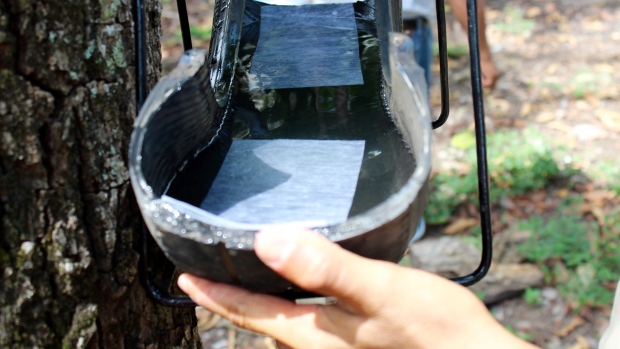Canadian-designed mosquito trap could help fight Zika virus
A Canadian-led research team has taken a form of trash that promotes the spread of mosquitoes and turned it into a potential weapon against the disease-carrying insects. The scientists have repurposed used tires — which can fill with rain water and provide an ideal breeding chamber for female mosquitoes — by fashioning chunks of the rubberized material into traps for their eggs.
“What we are aiming at is destroying the second generation of mosquitoes, by destroying the eggs and the larvae,” said Gerardo Ulibarri, a professor of biochemistry at Laurentian University in Sudbury, Ont.
Ulibarri and his fellow researchers tested the trap — dubbed an ovillanta — in Guatemala, where species of the Aedes mosquito can carry dengue, chikungunya and Zika. The insects transmit the viruses among people through their bites.
The ovillanta — “llanta” is one word in Spanish for tire — is made from a piece of tire shaped to contain water and a pheromone solution to attract female mosquitoes. The wall-hung vessel is fitted with a valve to direct the liquid to a filter so it can be recycled. After the eggs are trapped on paper strips, they are destroyed and the filtered water is reused.
“The key to this is the recycling of the solution,” Ulibarri said from Guadalajara, Mexico. “In these remote places, clean water is a luxury. So recycling saves a lot of water.”
 The bottom half of an “ovillanta,” a mosquito trap made out of repurposed used tires.
The bottom half of an “ovillanta,” a mosquito trap made out of repurposed used tires.
(Daniel Pinelo/Grand Challenges Canada/Canadian Press)
In a study conducted during a 10-month period starting in February 2015 in Sayaxche, Guatemala, the researchers compared how efficient the 84 ovillantas were in trapping mosquito eggs compared with the same number of ovitraps installed in a total of 14 neighbourhoods in the remote community of about 14,000 people.
They found their homemade tire traps captured almost seven times as many eggs — about 182,000 versus roughly 27,000 in the ovitraps.
“This is a long process, this is a preventive process,” Ulibarri said. “We are preventing the [next] generation of mosquitoes.”
The Guatemala study was initially intended to see how well the traps worked as a potential means of reducing transmission of the dengue virus, a potentially fatal infection.
“We didn’t think about the Zika virus because we hadn’t heard of it until the end of the project,” said Ulibarri. Since Zika is carried by the same kind of mosquito that harbours dengue and chikungunya, “we could extrapolate to the Zika virus” with testing of the ovillanta, Ulibarri said. “If we eliminate the mosquito, we can reduce the transmission of the Zika virus as well.”
The researchers proposed the Guatemalan study after they found that installing standard ovitraps around a site in Sudbury cut the number of mosquitoes that carry the West Nile virus by 90 per cent.
A followup study based on the same design resulted in a 71 per cent drop in the Aedes mosquito population in an area of Mexico.
Using worn-out tires to make the traps is inexpensive and ecologically beneficial — tires make up almost 30 per cent of mosquito breeding sites in the Guatemalan city.
The researchers hope use of the tire-based traps can be expanded to other countries affected by the mosquito-borne diseases.
A community in Paraguay and one in Mexico are trying out the devices, said Ulibarri, while in Guatemala “they are already expanding to other cities that are affected by the dengue fever, and now they are also scared of the Zika virus, of course.”
Read the full article on CBC.ca
